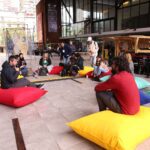- March 1, 2023
- Benjamin Pino

Debunking myths about the migrant community
There are several harmful beliefs that tend to spread in society when significant migration flows occur. Below, we gather reliable data and information to demolish them and, in several cases, prove that just the opposite is true.
When there are large flows of migrant populations, new challenges arise for the receiving communities. Issues of housing, work, integration and traditions intertwine to reinforce beliefs and some prejudices surrounding migration.
Due to the large number of myths and assumptions that arise as a result of this phenomenon, the Hola America Festival dedicated a space to demystify and inform with true facts and, in this way, prevent these beliefs from becoming hate speeches.
Juan Pablo González, a researcher with the Jesuit Migrant Service in Chile, said that in recent years a punitivist view of migration has predominated. That is, a point of view based on punishment, restriction of legal guarantees and a strong control on the integration of these communities.
This view reinforces one type of interpretation of the facts over others, which ends up influencing the decisions made by relevant actors, such as local governments and international entities, responsible for elaborating or curbing public policies on this issue.
In this sense, it is important that the protagonists engage in dialogue with each other, in order to have a wide variety of perspectives that allow innovative actions to be taken and to integrate new voices that nurture the discussion. Below, Hola America chimes in with its point of view.
Debunking myths about the migrant population
Myth: Migration is illegal
Reality: People are not illegal. States have the ability to enforce rules on the border entry process, but must maintain and protect the rights of all persons, including regular and irregular migrants.
In the Chilean case, Gonzalez shows that the data on entries through unauthorized passage since 2018 come largely from Cuba, Colombia, Haiti and Venezuela. This suggests that the motivation behind displacement does not always lie in personal conviction, but rather responds to a process forced by complex political situations.
Myth: The migrant population is an expense for the State.
Reality: According to data from the Chilean Internal Revenue Service and the Chilean Undersecretariat of the Interior, in 2019, the migrant population contributed $397 billion to the treasury The amount of the tax on income tax and fines on foreigners was $243 billion, while public spending related to migration in institutional, health, education and social programs reached $243 billion.
It is therefore a community that contributes, promotes greater dynamism in the labor market, the creation of new enterprises and jobs. In this sense, the State should not think about how many migrants it can receive but how many it is willing to manage.
Myth: Migrants are a threat to the domestic worker
Reality: The migrant population has the capacity to generate new jobs that benefit the local and foreign population. In addition, there is a low degree of substitution in the work performed by locals and migrants.
Myth: Migration increases crime
Reality: There is a disproportion between the commission of the crime and the perception of its commission. González found that crimes committed by the migrant population are related to infractions of sanitary measures, while in crimes of greater social connotation, more crimes were committed by Chileans than by the migrant population.
Myth: Migrants receive more subsidies than the local population.
Reality: The migrant population, being more vulnerable, may have access to assistance. Patterns of vulnerability allow them to opt for subsidies provided by the State, not because they are migrants but because they respond to certain needs.
If you are interested in this topic, we invite you to know the project
Hacking Narratives
dedicated to recognizing social innovation projects created by and for migrants.


